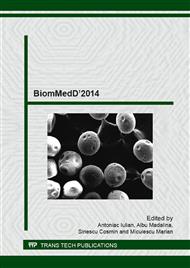p.249
p.255
p.262
p.270
p.274
p.280
p.286
p.296
p.303
The Use of Bone-Like Materials in Skull Base Traumatology
Abstract:
Introduction The mastoid has many functional roles that are well known in the literature. Less studied is the role of the mastoid in kinetic energy absorption during head trauma. The work hypothesis of this study was the question whether the mastoid obliteration with bone-like material plays a role in skull base traumatology during occipital trauma. Materials and methods The study was approved by the Ethics Committee of the University of Medicine and Pharmacy "Iuliu Haţieganu" from Cluj-Napoca and was performed on a formolized cephalic extremity. The calvaria was removed through a horizontal section in the upper third of the lambdoid suture, and the brain was also removed. The mastoid cells of the left temporal bone were removed by external approach. The resulting neocavity was filled with a mixture of calcium carbonate, white gypsum and hydroxyapatite. The mastoid cells of the right temporal bone remained intact. The occipital region of the cephalic extremity was impacted by a spherical object attached to a pendulum arm. Temporal bone fractures were evaluated by CT examination. Results The cephalic extremity was initially impacted at a speed of 3.55 m/s, with a kinetic energy of 56.71 J, which caused a fracture with depression in the occipital region, without causing temporal bone fracture. Subsequently, the same cephalic extremity was impacted at a speed of 4.13 m/s, with a kinetic energy of 76.75 J, which produced occipital comminuted fracture and right petrous apex fracture. Conclusions During the occipital impact on the studied cephalic extremity, the obliterated mastoid may play a higher role in protecting vital structures than the native mastoid.
Info:
Periodical:
Pages:
274-279
Citation:
Online since:
March 2015
Price:
Сopyright:
© 2015 Trans Tech Publications Ltd. All Rights Reserved
Share:
Citation:


